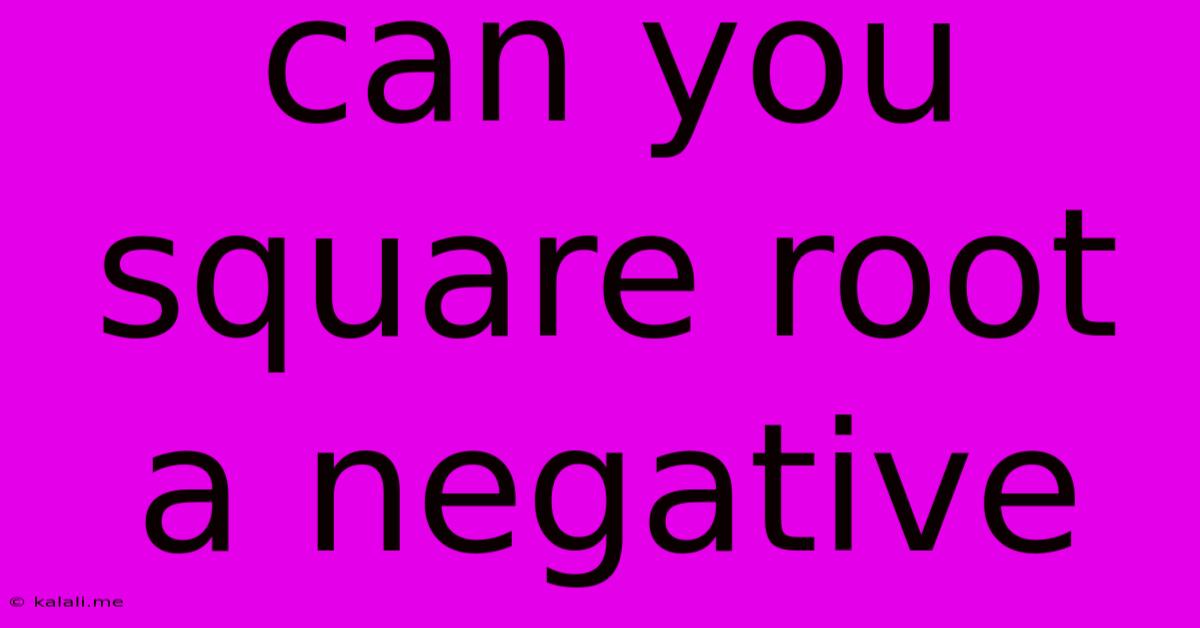Can You Square Root A Negative
Kalali
May 19, 2025 · 3 min read

Table of Contents
Can You Square Root a Negative Number? Exploring Imaginary Numbers
The simple answer is: no, you can't square root a negative number using only real numbers. This is because any real number, whether positive or negative, when multiplied by itself (squared), will always result in a positive number. This seemingly simple limitation led mathematicians to develop a whole new branch of numbers: imaginary numbers. This article will explore what imaginary numbers are, how they work, and their significance in mathematics.
This article will delve into the concept of imaginary numbers, explaining their properties, uses, and relevance in various fields. We'll also cover complex numbers, which combine real and imaginary components. Understanding imaginary numbers is crucial for anyone pursuing advanced mathematics, physics, or engineering.
Understanding the Problem: Real Numbers and Squares
Let's start with the basics. A square root asks: "What number, multiplied by itself, equals this number?" For example, the square root of 9 is 3 because 3 x 3 = 9. Similarly, the square root of 16 is 4. But what about the square root of -9? There's no real number that, when multiplied by itself, will give you a negative result. This is because:
- Positive x Positive = Positive
- Negative x Negative = Positive
This apparent roadblock spurred the development of a new number system.
Introducing Imaginary Numbers: The "i"
To solve the problem of square rooting negative numbers, mathematicians introduced the imaginary unit, denoted by the letter i. i is defined as the square root of -1:
√-1 = i
This might seem strange at first, but it's a fundamental building block of a broader mathematical system. Now we can express the square root of any negative number in terms of i. For example:
√-9 = √(9 x -1) = √9 x √-1 = 3i
√-16 = √(16 x -1) = √16 x √-1 = 4i
Complex Numbers: Combining Real and Imaginary
While i allows us to handle the square roots of negative numbers, most applications involve combining real and imaginary numbers. These are known as complex numbers. A complex number is written in the form:
a + bi
where 'a' is the real part and 'bi' is the imaginary part. For example, 2 + 3i is a complex number with a real part of 2 and an imaginary part of 3i.
Applications of Imaginary and Complex Numbers
Don't let the name "imaginary" fool you; these numbers have very real-world applications, particularly in:
- Electrical Engineering: Complex numbers are essential for analyzing alternating current (AC) circuits.
- Quantum Mechanics: Imaginary numbers play a crucial role in the mathematical formulations of quantum mechanics.
- Signal Processing: Complex numbers are used extensively in signal processing and image analysis.
- Fluid Dynamics: Complex analysis is used in solving certain types of fluid flow problems.
Conclusion: Expanding Mathematical Horizons
The introduction of imaginary numbers might seem like an abstract mathematical construct, but it's a vital expansion of our numerical system. It allows us to solve problems that would be impossible using only real numbers, opening doors to advancements in various scientific and engineering fields. While the concept might initially feel counterintuitive, the elegance and power of imaginary and complex numbers are undeniable.
Latest Posts
Latest Posts
-
Gold Is Good Conductor Of Electricity
May 20, 2025
-
Substitute For Crushed Red Pepper Flakes
May 20, 2025
-
Using Work Phone As Personal Phone
May 20, 2025
-
Train From El Prat To Sitges
May 20, 2025
-
Is Toothpaste A Liquid Or A Solid
May 20, 2025
Related Post
Thank you for visiting our website which covers about Can You Square Root A Negative . We hope the information provided has been useful to you. Feel free to contact us if you have any questions or need further assistance. See you next time and don't miss to bookmark.